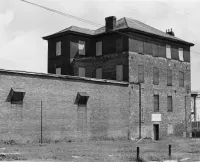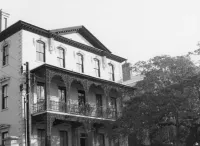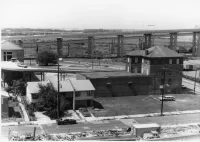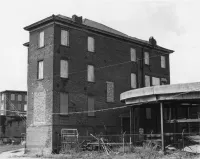Share what you know,
and discover more.
Share what you know,
and discover more.
Nov 27, 1979
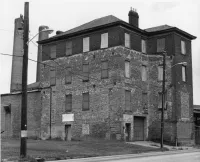
-

- Charmaine Bantugan
National Register of Historic Places - Josiah Smith Tennent House
Statement of Significant: The Josiah Smith Tennent House, located within the city limits of Charleston, South Carolina, is believed to have been built by Josiah Smith and Mary Ramsay Tennent circa 1859. The house is architecturally significant as a modified, detached Charleston single house exemplary of the Greek Revival influence and is historically significant both for its associations with locally prominent individuals and for its commercial use. Stylistic analysis and historic evidence indicate that Josiah Smith and Mary Ramsay Tennent constructed the house circa 1859 on property which had been conveyed to them in 1856 by her father. Dr. John Hyrne Tucker. A member of a prominent Charleston family, Tennent was a wealthy businessman and planter. He was a brick factor and was associated with the Planters' and Mechanics' Bank. In addition, he owned numerous tracts of land, including a plantation in St. James Parish, Goose Creek. An early volunteer for Confederate Service during the Civil War, Tennent served in Company A, Twenty-Seventh South Carolina Regiment (Gaillard's Regiment) until his death in 1864. Mrs. Tennent continued to reside in the house until 1870. Shortly thereafter, the Tennent House was purchased by Carsten Wulbern, a German emigrant who played a significant role in local commercial, religious and civic affairs. Following his return from Confederate Service during the Civil War as an officer in Company A, German Artillery, Wulbern entered the wholesale grocery business. He prospered and soon established his own firm, Wulbern and Pieper. In addition, Wulbern served as a director of both the Home Insurance Company and the Germania Savings Bank. He was an original pewholder of St. Matthew's Evangelical Lutheran Church and served as president of the congregation. A prominent civic leader, Wulbern served on the Charleston City Council as Alderman from Ward 9 from 1883 to 1887. He was also a member of the city Board of Equalization and a longtime representative to the city Department of Charities, serving as a commissioner of both the Alms House and the Colonial Common and Ashley River Embankment. Wulbern occupied the Tennent House until 1889, when he sold it to the Charleston Cotton Mills, a textile firm. (Established as the Charleston Manufacturing Company in 1880, the cotton mill went bankrupt in 1888 and was reorganized under the new name that same year.) The complex of buildings associated with the mill covered several city blocks, bounded roughly by Drake Street on the north, Columbus Street on the south, American Street on the west, and East Bay Street on the east. A part of this complex, the Tennent House itself served as a residence for the superintendent, and, it is believed, as the company offices. By 1896, the Charleston Cotton Mills was the only cotton manufacturing firm in the city, employing 645 people and having an annual product valued at $700,000. The mill was unable, however, to escape the general economic depression which affected Charleston's commercial and industrial interests in that year; it closed in June and by 1899 had ceased to exist. The Tennent House was subsequently purchased by the city of Charleston to be used as a storage facility for the municipal incinerator, located on the adjacent property. Unoccupied at present, the house continues to be owned by the city of Charleston. Architecture: The architectural significance of the Josiah Smith Tennent House derives in part from its survival as one of only several remaining antebellum townhouses in this vicinity of downtown Charleston and in part from its architectural form, which typifies the development of the modified, detached. Charleston single house. Notable architectural features presently extant include the floor plan with rooms grouped to the south and circulation arranged to the north and the detailing of the rooms and staircase at the third and fourth floor levels; following proposed restoration of the exterior, architectural features of note will once again include the south facade two story Greek Revival piazzas and the east facade Greek Revival front entrance portico.
National Register of Historic Places - Josiah Smith Tennent House
Statement of Significant: The Josiah Smith Tennent House, located within the city limits of Charleston, South Carolina, is believed to have been built by Josiah Smith and Mary Ramsay Tennent circa 1859. The house is architecturally significant as a modified, detached Charleston single house exemplary of the Greek Revival influence and is historically significant both for its associations with locally prominent individuals and for its commercial use. Stylistic analysis and historic evidence indicate that Josiah Smith and Mary Ramsay Tennent constructed the house circa 1859 on property which had been conveyed to them in 1856 by her father. Dr. John Hyrne Tucker. A member of a prominent Charleston family, Tennent was a wealthy businessman and planter. He was a brick factor and was associated with the Planters' and Mechanics' Bank. In addition, he owned numerous tracts of land, including a plantation in St. James Parish, Goose Creek. An early volunteer for Confederate Service during the Civil War, Tennent served in Company A, Twenty-Seventh South Carolina Regiment (Gaillard's Regiment) until his death in 1864. Mrs. Tennent continued to reside in the house until 1870. Shortly thereafter, the Tennent House was purchased by Carsten Wulbern, a German emigrant who played a significant role in local commercial, religious and civic affairs. Following his return from Confederate Service during the Civil War as an officer in Company A, German Artillery, Wulbern entered the wholesale grocery business. He prospered and soon established his own firm, Wulbern and Pieper. In addition, Wulbern served as a director of both the Home Insurance Company and the Germania Savings Bank. He was an original pewholder of St. Matthew's Evangelical Lutheran Church and served as president of the congregation. A prominent civic leader, Wulbern served on the Charleston City Council as Alderman from Ward 9 from 1883 to 1887. He was also a member of the city Board of Equalization and a longtime representative to the city Department of Charities, serving as a commissioner of both the Alms House and the Colonial Common and Ashley River Embankment. Wulbern occupied the Tennent House until 1889, when he sold it to the Charleston Cotton Mills, a textile firm. (Established as the Charleston Manufacturing Company in 1880, the cotton mill went bankrupt in 1888 and was reorganized under the new name that same year.) The complex of buildings associated with the mill covered several city blocks, bounded roughly by Drake Street on the north, Columbus Street on the south, American Street on the west, and East Bay Street on the east. A part of this complex, the Tennent House itself served as a residence for the superintendent, and, it is believed, as the company offices. By 1896, the Charleston Cotton Mills was the only cotton manufacturing firm in the city, employing 645 people and having an annual product valued at $700,000. The mill was unable, however, to escape the general economic depression which affected Charleston's commercial and industrial interests in that year; it closed in June and by 1899 had ceased to exist. The Tennent House was subsequently purchased by the city of Charleston to be used as a storage facility for the municipal incinerator, located on the adjacent property. Unoccupied at present, the house continues to be owned by the city of Charleston. Architecture: The architectural significance of the Josiah Smith Tennent House derives in part from its survival as one of only several remaining antebellum townhouses in this vicinity of downtown Charleston and in part from its architectural form, which typifies the development of the modified, detached. Charleston single house. Notable architectural features presently extant include the floor plan with rooms grouped to the south and circulation arranged to the north and the detailing of the rooms and staircase at the third and fourth floor levels; following proposed restoration of the exterior, architectural features of note will once again include the south facade two story Greek Revival piazzas and the east facade Greek Revival front entrance portico.
Nov 27, 1979
National Register of Historic Places - Josiah Smith Tennent House
Statement of Significant:The Josiah Smith Tennent House, located within the city limits of Charleston, South Carolina, is believed to have been built by Josiah Smith and Mary Ramsay Tennent circa 1859. The house is architecturally significant as a modified, detached Charleston single house exemplary of the Greek Revival influence and is historically significant both for its associations with locally prominent individuals and for its commercial use.
Stylistic analysis and historic evidence indicate that Josiah Smith and Mary Ramsay Tennent constructed the house circa 1859 on property which had been conveyed to them in 1856 by her father. Dr. John Hyrne Tucker. A member of a prominent Charleston family, Tennent was a wealthy businessman and planter. He was a brick factor and was associated with the Planters' and Mechanics' Bank. In addition, he owned numerous tracts of land, including a plantation in St. James Parish, Goose Creek. An early volunteer for Confederate Service during the Civil War, Tennent served in Company A, Twenty-Seventh South Carolina Regiment (Gaillard's Regiment) until his death in 1864. Mrs. Tennent continued to reside in the house until 1870.
Shortly thereafter, the Tennent House was purchased by Carsten Wulbern, a German emigrant who played a significant role in local commercial, religious and civic affairs. Following his return from Confederate Service during the Civil War as an officer in Company A, German Artillery, Wulbern entered the wholesale grocery business. He prospered and soon established his own firm, Wulbern and Pieper. In addition, Wulbern served as a director of both the Home Insurance Company and the Germania Savings Bank. He was an original pewholder of St. Matthew's Evangelical Lutheran Church and served as president of the congregation. A prominent civic leader, Wulbern served on the Charleston City Council as Alderman from Ward 9 from 1883 to 1887. He was also a member of the city Board of Equalization and a longtime representative to the city Department of Charities, serving as a commissioner of both the Alms House and the Colonial Common and Ashley River Embankment.
Wulbern occupied the Tennent House until 1889, when he sold it to the Charleston Cotton Mills, a textile firm. (Established as the Charleston Manufacturing Company in 1880, the cotton mill went bankrupt in 1888 and was reorganized under the new name that same year.) The complex of buildings associated with the mill covered several city blocks, bounded roughly by Drake Street on the north, Columbus Street on the south, American Street on the west, and East Bay Street on the east. A part of this complex, the Tennent House itself served as a residence for the superintendent, and, it is believed, as the company offices. By 1896, the Charleston Cotton Mills was the only cotton manufacturing firm in the city, employing 645 people and having an annual product valued at $700,000. The mill was unable, however, to escape the general economic depression which affected Charleston's commercial and industrial interests in that year; it closed in June and by 1899 had ceased to exist.
The Tennent House was subsequently purchased by the city of Charleston to be used as a storage facility for the municipal incinerator, located on the adjacent property. Unoccupied at present, the house continues to be owned by the city of Charleston.
Architecture: The architectural significance of the Josiah Smith Tennent House derives in part from its survival as one of only several remaining antebellum townhouses in this vicinity of downtown Charleston and in part from its architectural form, which typifies the development of the modified, detached. Charleston single house. Notable architectural features presently extant include the floor plan with rooms grouped to the south and circulation arranged to the north and the detailing of the rooms and staircase at the third and fourth floor levels; following proposed restoration of the exterior, architectural features of note will once again include the south facade two story Greek Revival piazzas and the east facade Greek Revival front entrance portico.
Posted Date
Jun 13, 2023
Historical Record Date
Nov 27, 1979
Source Name
National Register of Historic Places
Source Website
Delete Story
Are you sure you want to delete this story?


